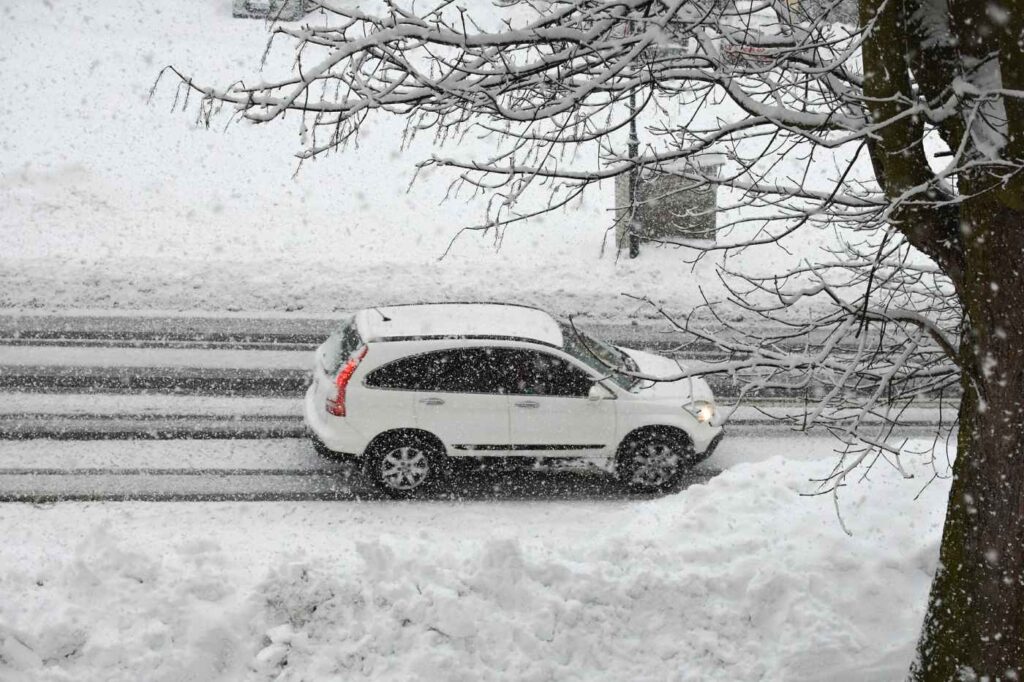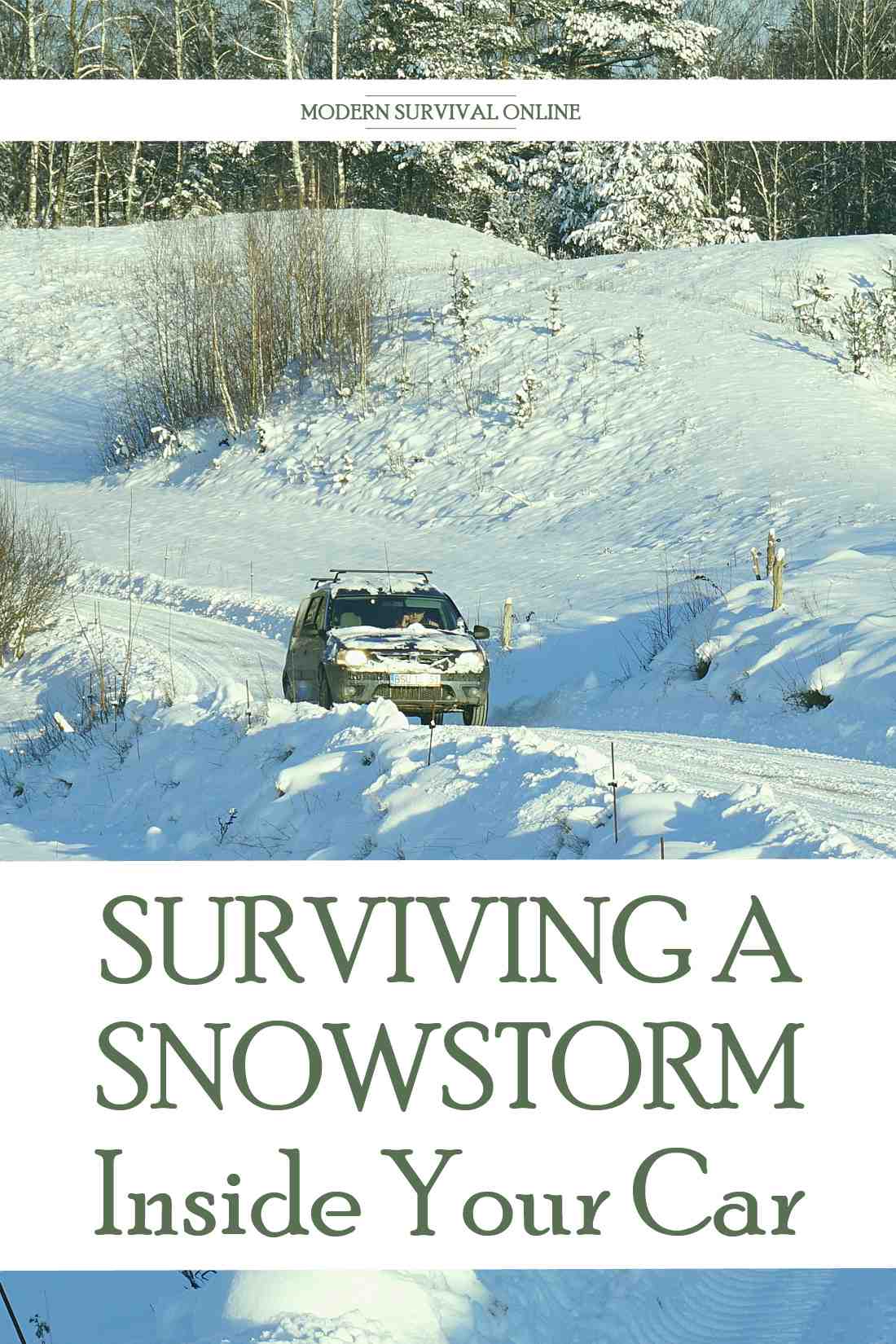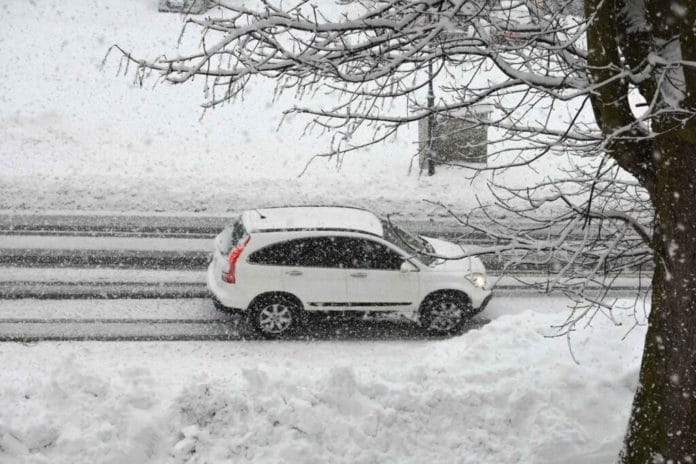Most preppers will be ably prepared for a variety of disasters when they are ensconced safe and sound at their fortified and well-stocked home, but fewer are prepared for dealing with emergencies while traveling.
One of the worst things that can happen to you when going by car or truck is being overtaken by a serious snowstorm. Snowstorms make travel innately dangerous and failing to prepare properly for one could land you in a legitimate survival situation.

So how do you survive a snowstorm inside your vehicle?
You can increase your chances of a positive outcome by equipping your vehicle with snow chains and proper tires, keeping it adequately maintained, and storing a winter survival kit on board along with your usual roadside emergency supplies.
By preparing correctly now you can avoid a grueling trial later. Snow storms are perennial causes of many crashes and strandings so you should take the time to learn everything you can prior to the onset of winter weather. I’ll tell you what you need to know below.
Traveling During a Snowstorm is Dangerous
You don’t need much imagination or even experience behind the wheel to understand how dangerous traveling by road can be under snowstorm conditions.
Snowstorms will coat roads with a dangerous layer of slush and ice while reducing visibility during periods of heavy snowfall.
That is a recipe for crashes left right and center. Every year the approach of winter sees automobile crashes, injuries and roadway fatalities skyrocket.
Not only are people not properly trained and attentive to handle driving in winter conditions but the vast majority of consumer vehicles cannot handle truly icy roadways.
Skidding and total loss of control will be the norm on roadways that have not been cleared of snow and treated with salt or other de-icing agents. Braking capability can be drastically reduced or even eliminated entirely. The stage is set for significant personal peril out on the roads.
What’s worse, stories abound of motorists becoming trapped and stranded due to massive pile-ups or just taking a wrong turn and running out of fuel or skidding off the road on some lesser-traveled route.
This might place you insignificant jeopardy considering you are likely traveling without a substantial survival kit if you are like most motorists.
How will you fare facing down the prospect of bitter cold and a potential death by exposure since no one is looking for you or even knows where to look for you? Waiting out the storm might not be an option.
Don’t Travel if You Don’t Have To
The smartest thing you can do when it comes to traveling by road during a snowstorm or other substantial winter weather event is not to.
That is probably what you don’t want to hear when you have an important trip to make or a long planned vacation you are looking forward to but it is the truth. The increased chances of mishap and misadventure are too high to ignore.
But even if you are a cautious and savvy prepper you might not have any choice. Sometimes life conspires like that and we are either overtaken by events or confronted with a situation of such pressing need that we have no choice but to carry on, weather and risk be damned.
If you find yourself in such circumstances you must be prepared for the dangers and the potential trials you’ll face.
You have to be prepared for long stays in your vehicle due to closed roads, traffic backup or crashes.
You must be prepared for invisible hazards like black ice, out of control vehicles and potentially getting lost due to poor visibility. Your vehicle is now more than a conveyance: It is a potential lifeboat should you become stranded.
Preventative Maintenance is the Key
Your vehicle probably gets put through the ringer already if it is your daily driver, but spring- and summertime driving conditions don’t hold a candle to the rough treatment it will face during winter.
Aggressive steering and braking along with exposure to ice, salt and slush that is comprised of at least 50% mystery grit will be very hard on all of your vehicle systems.
You should endeavor to keep your vehicle well maintained by staying on top of oil changes, inspections, repairing of broken parts and verification that all controls and signals are functioning.
Depending on the type of vehicle you drive you should also consider installing winter specific tires and even snow chains if they are legal in your area.
Snow chains in particular are one of the only things that will afford you any amount of traction should you find yourself on a completely iced over roadway.
Though they do increase wear and make for a choppy, bumpy, vibrating ride the trade-offs are definitely worth it when the alternative is losing control.
Assemble Your Winter Survival Kit
Preparing your vehicle for the onslaught of a snowstorm is only half the battle when it comes to surviving it. You’ll need to make sure your vehicle is also equipped with the supplies that the driver, you, and passengers need to survive the punishment of exposure.
Sure, you could just count on sitting tight, keeping the engine running and the heater blazing and listening to whatever songs you can pick up on the radio but that way lays disaster.
You must count on being stranded and potentially injured for a long period of time after an emergency occurring as a result of a snowstorm. There is much to consider.
- How will you keep warm when the fuel runs out or if the engine is not functional?
- How will you signal for help?
- Do you have any food for energy or any way to procure drinking water?
- How will you power your phone or other devices?

When you visit an external link on this page and then make a purchase, I may earn a commission. Read my full advertising disclosure here.
Consider adding the following items to your roadside winter survival kit:
- A full size spare tire, maintained
- Lug nut wrench, jack and other tools for basic repairs
- Belts, hoses, clamps and other essential spare parts
- Sand or kitty litter, for adding traction to slipping tires
- Magnetic, free-standing high visibility marker triangles.
- Folding shovel and scraper.
- Food, shelf stable ready to open and eat
- Blankets
- Additional clothing, including socks, gloves and headwear
- Emergency candles
- Fireproof container
- Road flares
- Power bank or fully charged spare cell phone battery
- First aid kit with trauma supplies
- … and more if this will also act as your bug-out vehicle
Your objective should be to remain inside the vehicle for as long as possible, taking advantage of the shelter it provides to stay as warm as you can.

Vehicle Survival Considerations
Despite your best efforts to avoid the event, you have been overtaken by a snowstorm while traveling and an accident or stranding has occurred. Now you are sitting still and occupying your vehicle. What do you do now?
Your first priority is to ensure the vehicle is not in any danger of being struck by additional traffic. This could be very difficult if you are unable to move due to damage or just a total loss of traction.
Assuming you can do so safely now is the time to deploy your high-visibility marker triangles or even your road flares. Hardly anything is more visible than a road flare, but they don’t last forever so use them as sparingly as you can.
Lacking either of these tools tie a brightly visible cloth to your antenna or drape it out of your window. This lets passersby and first responders know you are in distress.
If you have signal now is definitely the time to call for help. Call emergency services if you are able but if for whatever reason you are not able to raise them call whoever you can they can get the word out and get people looking for you.
Now is also the time to start acting conservatively. Running the car full time so you can have the heater on full blast is a rookie move and waste fuel. You should run the car only 15 or 20 minutes out of every hour to warm the cabin to a reasonably comfortable temperature.
You should also put on all of your additional clothing and break out the blankets. Your objective is just to stay warm enough where you aren’t completely miserable so you can save fuel for the Long haul in case the situation deteriorates that far.
One quick note on that: you or someone else will need to get out of the car periodically and ensure that the exhaust is not blocked by snow or other debris.
If this occurs it is highly likely that deadly CO (carbon monoxide) gas will infiltrate the cabin, poisoning and potentially killing the occupants.
This is a major threat if everyone is asleep. You have been warned!
Conclusion
Surviving winter’s onslaught is difficult and even more difficult when you are forced to endure it inside your vehicle. Winter weather causes thousands of crashes and deaths every single year, and leads to many more survival scenarios than are even recorded.
Take this threat seriously and prepare now for harsh winter weather so you are ready to meet it head on.



